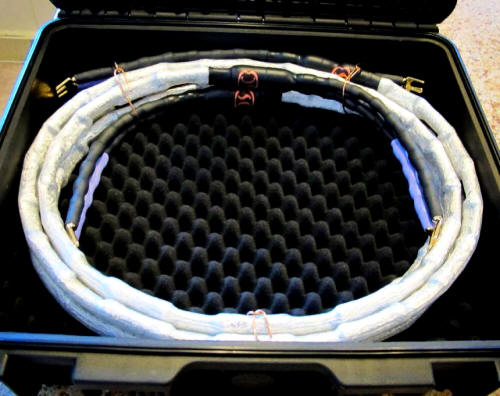|
|
You are reading the older HTML site
Positive Feedback ISSUE 75
skogrand SC Beethoven Speaker Cables - Pure as Snow as reviewed by Myles B. Astor
While Norway is best known for its fjords, Vikings, skiing, trolls and conspicuous consumption of coffee, the land of the midnight sun is also home to a number of small and extremely dedicated high-end audio manufacturers. Companies such as Electrocompaniet (one of the few amplifiers in its day that could drive the original BIG Apogees) have been around for decades but the first time I heard of Skogrand cables was when David Robinson awarded the SC Beethoven (then called the Ignis Purist) his 2013 Brutus award. Hopefully others will be similarly enlightened after reading this review! Skogrand's SC Beethoven speaker cable marks the newest addition to the company's cable line and designer Knut Skogrand's all out attack on the state-of-the-art in cable design. Incorporating cutting edge design and construction techniques, the SC Beethoven ranks among the very,very best cables that have passed through the system. The SC Beethoven speaker cables are extremely quiet, precise, coherent and resolving. In short, the SC Beethoven speaker cables do what the best cables should do: be seen and not heard! Now under normal conditions I would go about auditioning a complete loom of cables; in this case, however, the SCI Beethoven's interconnects stiffness combined with the arrangement of the equipment in my rack precluded this approach. (A while ago I learned the hard way about the havoc that stiff cables can wreak on RCA connectors.) While the SC Beethoven speaker cables are nowhere as stiff (or heavy) as say the Cable Research Labs (and by comparison a bantamweight) in comparison), don't expect to make any 90—much less 45 degree bends—with the speaker cable. More importantly, that stiffness factor needs to be accounted for when calculating the length of cable needed. Top of the Mountain The Skogrand SC Beethoven's "signature sound"—not unlike MIT's Oracle cable line—is defined by the speaker cable's vanishingly low noise floor. So quiet in fact, that when combined with top notch, low noise gear—and especially the Magico S5 speakers with their ultra-fast settling time—the cable's attributes are simply impossible to ignore. Be forewarned, however, that the cable's qualities don't manifest themselves right out of the shipping container. In fact, out of the many, many, many wires that have passed through the system, few, if any cables, have taken longer to burn- and settle-in than the SC Beethoven. Few cables have tried the patience more than the Skogrands. Yes, there's a glimpse of what's to come fresh out of the container; yet at the same time the SC Beethoven's are also maddeningly thin sounding. Three days on the Cable Cooker definitely helps, but still no cigar. It literally took another 100 hours of playing music through the Skogrands before the proverbial ugly duckling transformed into the gorgeous swan. Patience is truly a virtue. Once properly burned-in, however, the SC Beethoven's low noise, resolution and especially transparency really shine through. Now in the case of this reviewer, transparency is next to Godliness and ranks up there in importance somewhere between instrumental timbre and soundstaging. For instance, when venturing out to the Blue Note, Jazz Standard or Smoke clubs to catch some jazz or Carnegie Hall to immerse myself in some classical music, there's unlike many other cables (as well as other components), simply no sense of opaqueness or a blanket over the music. Live music isn't black (oh how I hate that buzz word and it ranks up there for me right there with the overuse of functional training) nor any other color of the rainbow for that matter. Live music is simply colorless, odorless, airy, open sounding and has an uncanny see through quality. And the SC Beethoven preserves those qualities allowing the "mind's eye" to better visualize the musicians whether they're in the front or the back of the soundstage on those wonderful Roy DuNann Contemporary or Rudy van Gelder Blue Note/Impulse jazz recordings. Not to mention a simply spellbinding ability to localize, separate, identify and visualize each of the male and female singers at the back of the stage on Bach's Quodlibet (Telefunken SAWT 9457-A). An ability to allow the rest of the system to capture the singer's voices echoing off the walls and resulting ambience. The one area, though, where the cables fall just oh-so short of ultimate lies in their ability to capture the totality of this recording venue. More importantly, however, the absence of "noise" or silence between notes is in the case of the SC Beethoven actually the presence of music (thanks to HP for turning that phrase!). Nor is this "silence" between the notes simply an audiophile abstraction. Classical composer Claude Debussy reportedly said, "Music is the space between the notes." No less than Miles Davis was quoted as saying, "Music is the space between the notes. It's not the notes you play; it's the notes you don't play." Or as someone once even more eloquently put it, "the space between notes allows them to resonate, reverberate, and reach their full measure of expression. Without this space, noise and cacophony would result." (Old timers may want to refer back to Tom Miiller's long forgotten and especially pertinent essay on Musicality that appeared in the pages of TAS many, many moons ago). In fact, it's nigh impossible to have correct instrumental timbre and in particular harmonic overtones without an accompanying side order—and a supersized one at that—of transparency. Otherwise musical harmonics become buried in the muck and mire of the noise floor and musical overtones are mistaken for grunge. Yes, that smearing, blurring and exaggeration may sound pretty but it's not real. The end result is that the extremely low noise floor—and silence between the notes of the SC Beethoven acts—act to reduce timbral "smearing." Reproduced harmonics are lighter, airier and more realistic. The Skogrands are as tonally coherent as cables come with only an ever-so-slight illumination of the upper midrange marring the wires exceptional performance. Almost as impressive is the SC Beethoven's lower octave performance. The Skogrand's have in the mid- and upper bass region an exceptional ability to resolve detail that especially complements and enhances the performance of the Magico S5s. For instance, take the sensational sounding Yarlung recording of J.S Bach's Suite No. 1 for Solo Cello MWV1007 from the Dialoghi sessions (Yarlung Records 15 ips tape release). The Skogrand/Magico combination produce a a level of detail, attack and precision normally only associated with panel speakers. Compared to one of my reference speaker cables (Transparent Audio Ref. XL MM2), the SC Beethoven is more detailed and captures more of the cello's richness and quickness, without exaggerating or smearing the instrument's sound. Last but not least, the SC Beethoven is at the top of its game when it comes to soundstaging and imaging. For instance, there's simply a vast and limitless sense of space on the Tape Project's release of the Reference Recording Arnold Overture (The Tape Project TTP 03) on this Watford Town Hall recording. More to the point, one doesn't even think about the soundstage because it unfolds oh so naturally. Crossing the Finishing Line As they say, good things come to those who wait. Those who are patient—and yes patience isn't a word commonly associated with audiophiles—will be rewarded with a cable with exceptional transparency, resolution, soundstaging, and timbral faithfullness. Skogrand's SC Beethoven is far from the cheapest cable on the market. Yet with the release of new "Super" cables from companies such as MIT, Transparent Audio,TARA Labs, etc, the SC Beethoven is today also far from the most expensive. More importantly this speaker cable really delivers the goods and should be on the top of the must-audition list for anyone who owns top flight speakers from Magico, Wilson, Marten, Sonus Faber, Raidho, etc. Technical Highlights Designer Knut Skogrand's two biggest pet peeves with current cable designs involves their tendency to constrict and distort the signal passing through them as well as a lack of silence. Knut's goal, consequently, in designing the SC Beethoven cables was to make his cables as, "true to its source or the components they connect," and allow the listener to, "truly distinguish what each and every component of their setup is capable of." And the key to achieving his goal is Knut's use of a vacuum dielectric to lower the cable's dielectric constant to as close to the theoretically desirable value of 1.0 as is humanly possible. Knut's primary objective with the newest SC Beethoven cables was to surpass the performance of his earlier designs by, "stripping away all obstacles in the signal path." Achieving this goal Knut shared, "involved careful attention to both signal and energy transfer speed and turned out to be an extremely time consuming and costly process." Construction of the SC Beethoven begins with using a using PFA (a perfluoroalkoxy copolymer resin) inner framework instead of PTFE (polytetrafluoroethylene and a granular molding powder) in Markarian 421. Why change the fluoroplastic framework? According to Knut, "the advantages of this fluoroplastic include a reduction in the stored static charge, slightly better flexibility and impact strength and 4.45 times higher dielectric strength. Additionally, ultra low dielectric fabrics are used in the construction of the SC Beethoven to help maintain the stable vacuum dielectric value of 1.0. The heart and soul of the SC Beethoven cables are 4 x 12 AWG solid-core copper leads running in parallel (in contrast to the Markarian's two solid-core leads that slightly spiral within the vacuum). Nor would any old ordinary copper suffice for Knut's statement cables. No, the SC Beethoven only uses mechanical, thermal and biologically treated Ultra-Pure Ohno Continuous Cast copper wires (with improved surface quality and electrical conductivity) set in a vacuum. Then, both the copper wires and the inner framework materials are scanned using three different x-ray techniques to eliminate any grain borders thus ensuring that every wire length of each cable 1) consists of only one copper crystal and 2) is free from impurities. Finally, all wires are matched for exact similarity of size and performance. Lastly, the speaker cables can be terminated with either gold spades or z-plug bananas with a supporting gold plated center pin. The review sample as requested arrived with fitted spades; these spades are custom ordered by Knut and further customized in house to fit the SC Beethoven's cable build and wire framework. Myles B. Astor
SC Beethoven Speaker Cables
Skogrand
|









